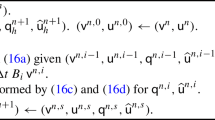Abstract
We present a boundary element method to compute numerical approximations to the non-linear Molodensky problem, which reconstructs the surface of the Earth from the gravitational potential and the gravity vector. Our solution procedure solves a sequence of exterior oblique Robin problems and is based on a Nash-Hörmander iteration. We apply smoothing with the heat equation to overcome a loss of derivatives in the surface update. Numerical results show the error between the approximation and the exact solution in a model problem.
Similar content being viewed by others
References
Ardalan A.A. and Grafarend E.W., 2001. Somigliani-Pizzetti gravity: The international gravity formula accurate to the sub-nanoGal level. J. Geodesy, 75, 424–437.
Costea A., Gimperlein H. and Stephan E., 2013. A Nash-Hörmander iteration and boundary elements for the Molodensky problem. Numer. Math., DOI: 10.1007/s00211-013-0579-8 (in print).
Čunderlík R. and Mikula K., 2010. Direct BEM for high-resolution global gravity field modelling. Stud. Geophys. Geod., 54, 219–238.
Čunderlík R., Mikula K. and Mojzeš M., 2008. Numerical solution of the linearized fixed gravimetric boundary-value problem. J. Geodesy, 82, 15–29.
Čunderlík R., Mikula K. and Tunega M., 2013. Nonlinear diffusion filtering of data on the earths surface. J. Geodesy, 87, 143–160.
Fasshauer G. and Jerome J.W., 1999. Multistep approximation algorithms: Improved convergence rates through postconditioning with smoothing kernels. Adv. Comput. Math., 10, 1–27, DOI: 10.1023/A:1018962112170.
Freeden W. and Mayer C., 2006. Multiscale solution for the Molodensky problem on regular telluroidal surfaces. Acta Geod. Geophys. Hungarica, 41, 55–86.
Heck B., 2002. Integral equation methods in physical geodesy. In: Grafarend E.W., Krumm F.W. and Schwarze V.S. (Eds.), Geodesy — The Challenge of the 3rd Millenium. Springer-Verlag, Heidelberg, Germany, 197–206.
Heiskanen W.A. and Moritz H., 1993. Physical Geodesy. W.H. Freeman, San Francisco, CA.
Holota P., 1997. Coerciveness of the linear gravimetric boundary problem and a geometrical interpretation. J. Geodesy, 71, 640–651.
Hörmander L., 1976. The boundary problems of physical geodesy. Arch. Rational Mech. Anal., 62, 1–52.
Jerome J.W., 1985. An adaptive Newton algorithm based on numerical inversion: regularization as postconditioner. Numer. Math., 47, 123–138.
Klees R., van Gelderen M., Lage C. and Schwab C., 2001. Fast numerical solution of the linearized Molodensky problem. J. Geodesy, 75, 349–362, DOI: 10.1007/s001900100183.
Maischak M., 2001a. Analytical Evaluation of Potentials and Computation of Galerkin Integrals on Triangles and Parallelograms. Technical Report, ifam50 (http://www.ifam.unihannover.de/~maiprogs/).
Maischak M., 2001b. Technical Manual of the Program System maiprogs (http://www.ifam.unihannover.de/~maiprogs/).
Molodensky M., 1958. Grundbegriffe der geodätischen Gravimetrie. VEB Verlag Technik, Berlin, Germany (in German).
Molodensky M.S., Yeremeev V.F. and Yurkina M.I., 1960. Methods for study of the external gravitational field and figure of the Earth. TRUDY TsNIIGAiK, 131, Geodezizdat, Moscow, Russia (English translat.: Israel Program for Scientific Translation, Jerusalem 1962).
Moser J., 1966a. A rapidly convergent iteration method and nonlinear differential equations — I. Ann. Scuola Norm. Sup. Pisa, 20, 265–315.
Moser J., 1966b. A rapidly convergent iteration method and nonlinear differential equations — II. Ann. Scuola Norm. Sup. Pisa, 20, 499–535.
Nash J., 1960. The embedding problem for Riemannian manifolds. Ann. Math., 63, 20–23.
Schulz H., Schwab C. and Wendland W.L., 1998. The computation of potentials near and on the boundary by an extraction technique for boundary element methods. Comput. Meth. Appl. Mech. Eng., 157, 225–238.
Schwab C., 1994. Variable order composite quadrature of singular and nearly singular integrals. Computing, 53, 173–194.
Schwab C. and Wendland W.L., 1999. On the extraction technique in boundary integral equations. Math. Comp., 68, 91–122.
Seo S., Chung M.K. and Vorperian H.K., 2010. Heat kernel smoothing using Laplace-Beltrami eigenfunctions. In: Jiang T., Navab N., Pluim J.P.W. and Viergever M.A. (Eds.), Medical Image Computing and Computer-Assisted Intervention — MICCAI 2010: Part III. Lecture Notes in Computer Science 6363, Springer-Verlag, Heidelerg, Germany, 505–512.
Author information
Authors and Affiliations
Corresponding author
Rights and permissions
About this article
Cite this article
Banz, L., Costea, A., Gimperlein, H. et al. Numerical simulations for the non-linear Molodensky problem. Stud Geophys Geod 58, 489–504 (2014). https://doi.org/10.1007/s11200-013-0141-2
Received:
Revised:
Accepted:
Published:
Issue Date:
DOI: https://doi.org/10.1007/s11200-013-0141-2




